- English
- Esta página
- Página inicial
- Arabic (اللغة العربية)
- Chinese (简体中文)
- French (Français)
- Haitian Creole (Kreyòl Ayisyen)
- Hindi (जानकारी)
- Korean (한국어)
- Polish (język polski)
- Portuguese (Português)
- Russian (Русский)
- Spanish (Español)
- Tagalog (Tagalog)
- Ukrainian (Українська)
- Vietnamese (Tiếng Việt)
- All Languages
Español
PDFs by language
Our 24/7 cancer helpline provides information and answers for people dealing with cancer. We can connect you with trained cancer information specialists who will answer questions about a cancer diagnosis and provide guidance and a compassionate ear.
![]()
Chat live online
Select the Live Chat button at the bottom of the page
Our highly trained specialists are available 24/7 via phone and on weekdays can assist through video calls and online chat. We connect patients, caregivers, and family members with essential services and resources at every step of their cancer journey. Ask us how you can get involved and support the fight against cancer. Some of the topics we can assist with include:
- Referrals to patient-related programs or resources
- Donations, website, or event-related assistance
- Tobacco-related topics
- Volunteer opportunities
- Cancer Information
For medical questions, we encourage you to review our information with your doctor.
Types of Ileostomies and Pouching Systems
An ileostomy can be short-term (temporary) or life-long (permanent). The different types of ileostomies are described here.
Temporary ileostomies
Certain bowel problems may be treated by giving part of the bowel a rest or with surgery to remove the damaged part. The bowel must be kept empty so it can heal. To keep stool from getting to the bowel, a short-term (temporary) ileostomy is created. Healing usually takes a few weeks or months, but may take years. In time, the ileostomy will be surgically reversed (removed) and the bowel will work much like it did before. A temporary ileostomy can also be done as the first stage in forming an ileo-anal reservoir (or J-pouch).
Permanent ileostomies
When part of the bowel becomes diseased, a long-term (permanent) ileostomy must be made. The diseased part of the bowel and anus are removed or permanently rested. In this case, the ileostomy is considered permanent and is not ever expected to be closed (removed).
There are 3 major types of ileostomies. You and your surgeon will talk about your options and together decide on the best surgery for you. Sometimes an ostomy nurse will also help you learn more so you are making the best decision. Some of the things to think about when planning an ileostomy are the disease process, your age, your general health, and your preference.
Standard or Brooke ileostomy
Reasons for the surgery: Ulcerative colitis Crohn’s disease Familial polyposis Cancer-related problems |
Output: Liquid or paste-like constant drainage that contains digestive enzymes |
Management: Skin protection is needed; use an open-ended pouch that can be emptied |
The standard or Brooke ileostomy surgery is the most common type. The end of the ileum is pulled through the abdominal wall and is turned back and sutured to the skin, leaving the smooth, rounded, inside-out ileum as the stoma.
The stoma is usually in the right lower part of the abdomen, on a flat surface of normal, smooth skin. The fecal output is not controlled. This means you’ll need to wear a collection pouch all the time, and empty it regularly.
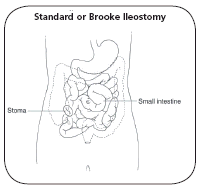
Continent ileostomy (abdominal pouch)
Reasons for surgery: Ulcerative colitis Familial polyposis Cancer-related problems |
Output: Liquid or paste-like drainage |
Management: Drain fairly often with a small tube (catheter) and use a stoma cover |
A continent ileostomy is a different type of standard ileostomy. You don’t need to wear an external pouch with this kind of ileostomy.
It’s made by looping part of the ileum back on itself so that a reservoir or pocket is formed inside the belly (abdomen). A nipple valve is made from part of the ileum. A few times each day you put in a thin, soft tube called a catheter to drain the waste out of the reservoir inside your belly.
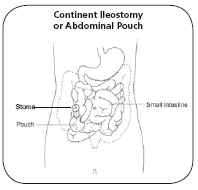
Ileo-anal reservoir (J-pouch or pelvic pouch)
Reasons for surgery: Ulcerative colitis Familial polyposis |
Output: Soft, formed stool |
Management: Natural bowel movements take place, but you need to protect the skin around the anus |
The ileo-anal reservoir or pelvic pouch is a pouch made from the ileum and the rectum and placed inside the body in the pelvis. Other names for this include J-pouch, W-pouch, and S-pouch depending on the surgical procedure.
The pouch is connected to the anus. Waste passes into the pouch, where it’s stored. When an “urge” is felt, the stool is passed through the anus, out of the body. The sphincter muscle around the anal opening must be intact to keep the pouch from leaking. The consistency of the output of the pelvic pouch depends on what you eat and drink, and may be managed with medicines. In most cases at least 2 surgeries are needed to make the ileo-anal reservoir or pelvic pouch.
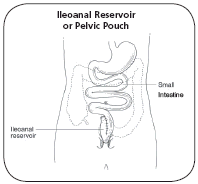
Choosing a pouching system
Deciding what pouching system or appliance is best for you is a very personal matter. When you’re trying out your first pouching system, it’s best to talk with an ostomy nurse or someone who has experience in this area. There should be someone in the hospital who can get you started with equipment and instructions after surgery.
As you’re getting ready to leave the hospital, be sure you are referred to a Wound Ostomy Continence nurse (WOCN or WOC nurse, also called an ostomy nurse), a clinic, an ostomy manufacturer, or a chapter of the United Ostomy Associations of America. Even if you must go out of town to get such help, it’s worthwhile, as you want to get a good start and avoid mistakes. Even with help, you may have to try different types or brands of pouching systems to find the one that best suits you.
There are many things to think about when trying to find the pouching system that will work best for you. The length of the stoma, abdominal firmness and shape, the location of the stoma, scars and folds near the stoma, and your height and weight all must be considered. Special changes may have to be made for stomas near the hipbone, waistline, groin, or scars. Some companies have custom-made products to fit unusual situations.
A good pouching system should:
- Stay secure, with a good leak-proof seal that lasts for up to 3 days
- Be odor-resistant
- Protect the skin around the stoma
- Be nearly invisible under clothing
- Be easy to put on and take off
- Allow you to shower or bathe with the pouch on, if you wish to do so
Types of pouching systems
Pouches come in many styles and sizes, and an ostomy nurse can help you choose the best one for your situation and lifestyle. They all have a collection pouch to collect stool drainage that comes out of the stoma and an adhesive barrier (called a flange, skin barrier, or wafer) that protects the surrounding skin. There are 2 main types of systems available:
- One-piece pouches have both a pouch and skin barrier attached together in the same unit. When the pouch is removed, the barrier also comes off.
- Two-piece systems have a pouch and a separate skin barrier.. When the pouch is taken off, the barrier stays in place.
Depending on the design of your pouch's skin barrier, you may need to cut a hole out for your stoma, or it may be sized and pre-cut. It’s designed to protect the skin from the stoma output and be as gentle to the skin as possible.
Some pouching systems can be opened at the bottom for easy emptying. Others are closed and are taken off when they are full. Still others allow the adhesive skin barrier to stay on the body while the pouch may be taken off, washed out, and reused. Pouches are made from odor-resistant materials and vary in cost. They can be either clear or opaque and come in different lengths.
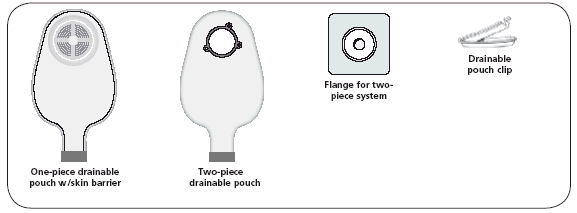
After surgery, the stoma may be swollen for about 6 to 8 weeks. During this time the stoma should be measured about once a week. A measuring card may be included in boxes of pouches, or you can make your own template to match your stoma shape. The opening on the skin barrier should be no more than 1/8 inch larger than the stoma.
Belts and tape
Wearing a belt to help hold the pouch in place is a personal choice. Some people with ileostomies wear a belt because it makes them feel more secure and it supports the pouching system. Others find a belt awkward and use tape instead. Tape can be put around the outside edge of the skin barrier like a frame.
If you choose to wear a belt, adjust it so that you can get 2 fingers between the belt and your waist. This helps to keep you from getting a deep groove or cut in the skin around the stoma which can cause serious damage to the stoma and sores (pressure ulcers) on the nearby skin. If a belt is used, it shouldn’t ride above or below the level of the belt tabs on the pouching system. People in wheelchairs may need special belts. Supply companies often carry these special belts or an ostomy nurse can talk to you about making one yourself.
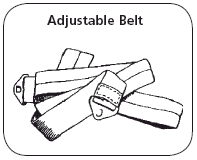
- Written by
- References

The American Cancer Society medical and editorial content team
Our team is made up of doctors and oncology certified nurses with deep knowledge of cancer care as well as journalists, editors, and translators with extensive experience in medical writing.
In its original form this document was written by the United Ostomy Association of America (1962-2019). It has since been modified and updated by the American Cancer Society using the following sources.
Berti-Hearn L, Elliott B. Ileostomy care: A guide for home care clinicians. Home Healthcare Now. 2019; 37(3):136-144.
Hollister. Ileostomy: What’s right for me. Accessed at http://www.hollister.com/~/media/files/pdfs–for–download/ostomy–care/whats–right–for–me–-–ileostomy_907602-806.pdf on October 2, 2019.
United Ostomy Association of America (UOAA). New ostomy patient guide: Colostomy, ileostomy, urostomy, continent diversion. Accessed at https://www.ostomy.org/wp-content/uploads/2018/05/All-In-One-New-Patient-Guide_2018.pdf on October 2, 2019.
United Ostomy Association of America (UOAA). Ileostomy guide. Accessed at https://www.ostomy.org/wp-content/uploads/2018/03/IleostomyGuide.pdf on October 2, 2019.
Last Revised: October 16, 2019
American Cancer Society medical information is copyrighted material. For reprint requests, please see our Content Usage Policy.
American Cancer Society Emails
Sign up to stay up-to-date with news, valuable information, and ways to get involved with the American Cancer Society.


